Sitmar Line - TSS Fairsky (2) 1957-1977

With Reuben Goossens.
Maritime
Historian, Cruise‘n’Ship Reviewer & Author
Please
Note: All ssMaritime and other related maritime/cruise
sites are 100% non-commercial and privately owned. Be assured that I am NOT
associated with any shipping or cruise companies or any travel/cruise agencies
or any other organisations! Although the author has been in the passenger
shipping industry since 1960, although is now retired but having completed
around 1,700 plus Classic Liners and Cargo-Passengers
Ships featured and I trust these will continue to provide classic ship
enthusiasts the information the are seeking, but above all a great deal of
pleasure! Reuben Goossens
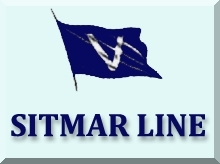
The
Sitmar Ships
Part
Four
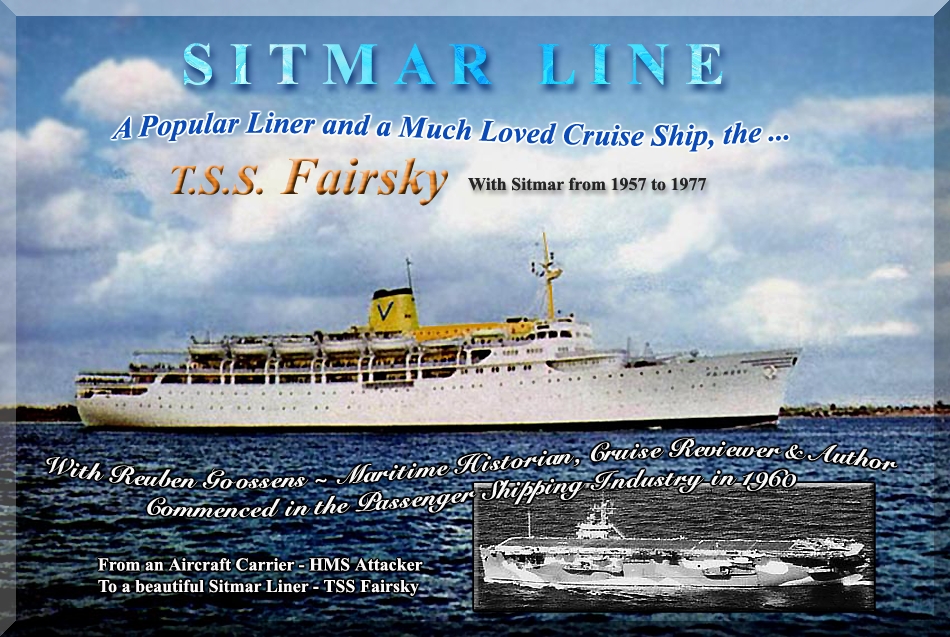
PLEASE
NOTE: Photographs on this page are from the author’s
collection or as noted
Introduction to
“The Sitmar Ships”:
Over
the years I have received unbelievable numbers of requests to add a feature on
all the Sitmar Liners and Cruise Ships. Well, it has taken a considerable time,
but in this work, I will present a short history on each ship, together with a
number of photographs. Therefore, I hope and pray that the following pages will
have you reliving your Sitmar experience or possibly experiences, be it sailing
to or from Europe/UK to New Zealand
or Australia or the America’s
on a line voyage or later as a passenger on one of their many cruises!
I certainly have enjoyed writing and compiling
this very special feature on a company that I greatly love and have sailed with
many times!
Thus now go and read all about … The Sitmar Ships.
Reuben
Goossens.
The
Beginnings of the Ship that became TSS Fairsky 2:
The ship that would
become the TSS Fairsky did have a rather amazing life before her remarkable
transformation, for she served during World War II as an “Attack Class
Aircraft Carrier” with great distinction, and it is for that reason, I
believe that we should know a little of her earlier life, which was an heroic
one!
The ship had been laid down on April 17, 1941
as a C3 Class freighter, the Steel Artisan, or “hull 160” under
Maritime Commission contract by “Western Pipe and Steel Company,”
San Francisco, California for the “Ithanian Steamship Company” and
she was launched late September. Upon completion in December 1941, she was
requisitioned for to be converted into an aircraft carrier and she was renamed
USS Barnes, but she was quickly selected to be transferred under the
“Lend-Lease” agreement to the British Royal Navy.
HMS Attacker (DO2) was the lead ship in the
Attacker Class of eight Escort Carriers and just one of the 38 escort carriers
built in the United
States for the Royal Navy during the Second
World War. Western Pipe & Steel shipyards also built three other ships in
the Attacker Class. Once completed the Attacker was headed to Britain
and was handed over to the Royal Navy under the agreement. HMS Attacker had a
ships complement of 646 men, who lived in crew accommodation that was
significantly different from the old Royal Navy arrangements for the time. No
longer would separate messes have to prepare their own food, for on Attacker
there was just a single Galley where everything was cooked and served food was
served in a cafeteria style in partaken off in a central dining area. She was
also equipped with an all-electric modern laundry as well as a Hairdresser.
Finally, gone were those dreaded traditional hammocks, which were replaced by
three-tier bunk-beds, 18 to a cabin, the beds were hinged and could be tied up
to provide more space when they were not in use.
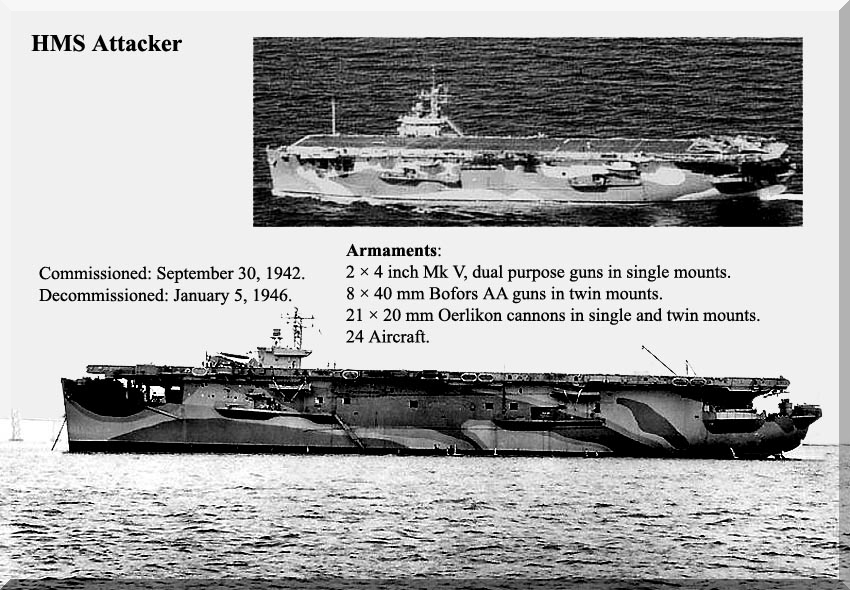
Before entering
service with the Royal Navy she was sent to Burrards shipbuilders in British
Columbia for one hundred and fifty modifications. These
were paid for by the Canadian government. Further modifications to turn her
into an assault carrier were undertaken by the Caledon Shipbuilding &
Engineering Company in Dundee,
Scotland. This work
included the installation of an operational telephone system with over 100
telephones, as well as a new briefing room and additional cabins providing an
additional 140 bunks.
HMS Attacker’s
dimensions were as follows: she had an overall length of 492.25 feet
(150.04 m), a beam of 69.5 feet (21.2 m) and a height of
23.25 ft (7.09 m). She displaced 11,420 long tons or 11,600 tons
at deep load. Propulsion was provided by four diesel engines connected to
single shaft giving 8,500 brake horsepower (6,300 kW), giving the ship a
speed of 17 knots (31 km/h; 20 mph), was could do 17.5 if required.
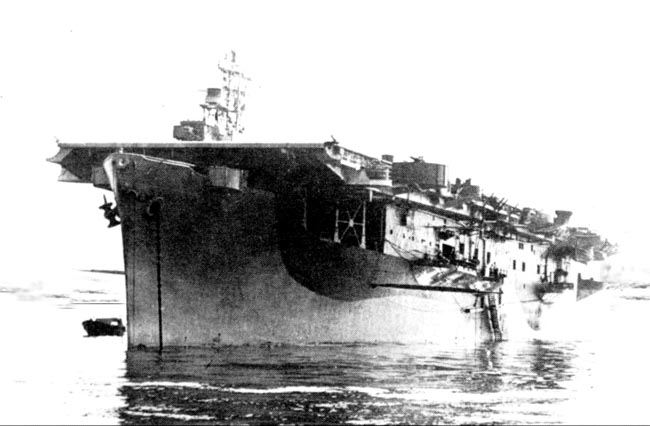
The
Attacker Class Escort Carrier - HMS Attacker DO2
In her
Hanger, she had the capacity for up to 24 anti-submarine or fighter aircraft,
which could be made up of a mixture of the British Hawker Sea Hurricane,
Supermarine Seafire, Fairey Swordfish or the American Grumman Wildcat, Vought
F4U Corsair or Grumman Avenger aircraft. The composition of aircraft would
depend on the squadrons that had embarked, and thus it depended on the mission.
Some squadrons were composite squadrons for convoy defence and would be
equipped with anti-submarine and fighter aircraft, while other squadrons
working in a strike carrier role would only be equipped with fighter aircraft.
Aircraft facilities were a relatively small combined Bridge–Flight
Control on the starboard side and above the 450 feet (140 m) x 120 feet
(37 m) flight deck, two Aircraft Lifts 42 feet (13 m) by 34 feet
(10 m), and nine Arrestor Wires. Aircraft could be housed in the 260 feet
(79 m) by 62 feet (19 m) Hangar below the flight deck. The ships
armament concentrated on anti-aircraft (AA) defence and comprised Two × 4 inch Mk V dual purpose guns in single mounts,
eight × 40 mm Bofors AA guns in twin mounts and twenty one × 20 mm
Oerlikon cannons in single and twin mounts..
Attacker was designed to accompany other ships
forming the escort for convoys. The anti-submarine aircraft employed were
initially the Fairey Swordfish and later the Grumman Avenger, which could be
armed with torpedoes, depth charges, 250 pounds (110 kg) bombs or the RP-3
rocket projectile. As well as carrying out their own attacks on U-Boats, these
aircraft identified their locations for the convoy's escorts to mount an
attack. Typically anti-submarine patrols would be flown between dawn and dusk.
One aircraft would fly about 10 miles (16 km) ahead of the convoy, while
another patrolled astern. Patrols would last between two and three hours, using
both Radar and visual observation in their search for U-Boats. Attacker also
had a secondary role, providing oil and provisions for her accompanying
destroyers. This could be a lengthy process and was done on the move. It took
40 minutes from firing a line across to the destroyer to start pumping oil,
while it took another two hours to pump 98 tons of oil and a further 35 minutes
to disconnect the hosepipe and secure the equipment.
HMS Attacker received special Honours and
Awards for services when in the following fields of Battle:
Salerno 1943 … Atlantic 1943–1944
… South France 1944 and the Aegean
1944. During her wartime duties she also served in the waters of
France as well as the Pacific. There is no doubt that she had a notable wartime
career and thus her many honours! After she had completed her duties she was
returned to the USA
in January 1946 and was duly laid up and placed on the market.
TSS Castelforte:
It was not until October 28,
1948 that the ship was sold to “National Bulk Carriers” of New York
and she was intended to be converted as a cargo ship and soon her flight deck
and other fittings were due to be removed. However work was soon halted because she had been purchased in 1950 by Navcot Corporation, being one of
the companies set up by Alexander Vlasov, the founder of Sitmar Lines. She was
renamed Castelforte and registered under the Panamanian flag. As was
the custom, foreign countries had to request permission for conversion works to
be undertaken by an US
shipyard from the “American Maritime Commission before removing an
American ship overseas. Then in 1952 she entered the Newport News Shipbuilding
and Drydock Co, where a plan was drawn up for her to become a reefer ship to
transport meat from Argentina to Europe. However, the reefer plan
was soon halted and she was placed into a four-year lay-up during which time
she received general maintenance to keep the ship in good order.
TSS Castel Forte:
During her lay up in 1954, her
name was altered from Castelforte to Castel Forte.
But finally, in February 1957 she was back in the shipyard and workers
came back on board and commenced necessary work to make her fit to sail again
as well as other major modifications. In Dry
Dock her hull had been modified as she was given a new extended beautifully
raked bow! In addition, her engine plant had been completely overhauled and
air-conditioning compressors had been installed on board, at the time she
certainly did not look much of a passenger ship, having only a small central
housing, which was mounted by the Bridge and a basic cylindrical smokestack,
but the end result was going to be stunning!
With the required hull and machinery work
completed, the Castle Forte sailed to Italy
and arrived in Genoa
with a crew of 43 under the command of Captain Jorge Petrescu on January 28,
1958. She berthed at the T. Marotti shipyards fit-out berth, where the company
worked together with 120 other Italian firms in the mammoth task transforming
this vessel into a remarkable modern Passenger Liner!
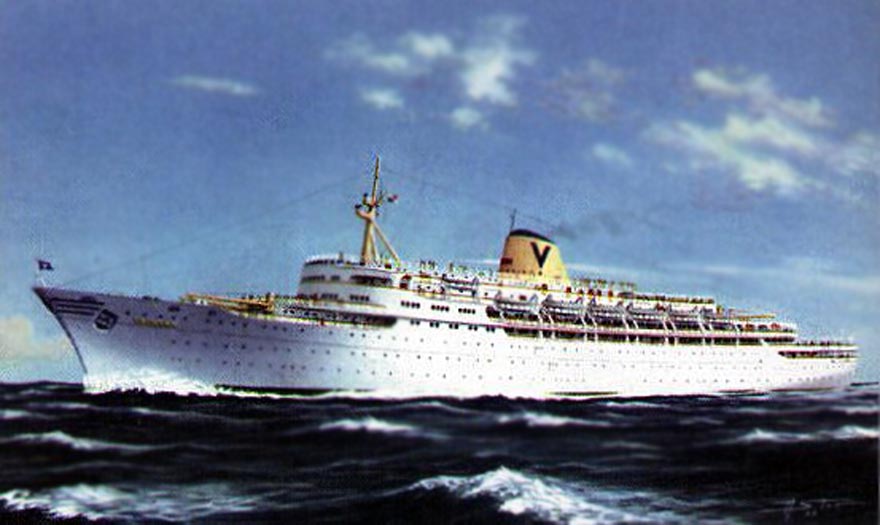
At
the time the TSS that had would have four decks; Promenade, Boat,
Sun and Navigation Decks, and the forward part of her superstructure was gently
and perfectly rounded and atop of her bridge was a well-designed tall tripod
radar mast. Amidships, there was her delightfully modern shapely funnel, which
was rather reminiscent of recent “Ansaldo” Trans-Atlantic Liners as
some said at the time. It was obvious that this new Sitmar liner was being
carefully designed by some of Italy’s
and Europe’s very best designers!
Her interiors were designed by some of Italy’s
greatest interiors designers, one of thee being the great German designer Mr
Störmer from Bremen,
yet the Fairsky still had that modern Italian feel throughout! She offered
accommodations in 441 cabins located over five Decks, being: D, C. B, A and Sun
Decks, which provided a total of 1,461 berths in a One Class configuration.
Staterooms with private facilities: Up on Sun
Deck Outside “Deluxe Staterooms” A, B, C, D and Inside
“Stateroom” E all had a spacious bathroom with a full bath with an
overhead shower, washbasin and WC. The four Deluxe Staterooms were outside and
all had a sofa that converted into a bed, as well as two berths along, thus
these staterooms could be sold for two or three persons as required.
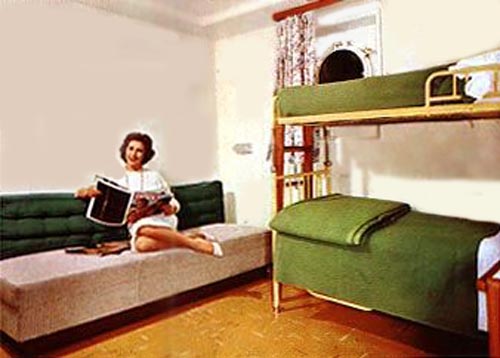
Outside
Stateroom D having the sofa bed along the wall and the two berths along the
outside
A,
B and C had their sofa beds along the outside wall and the berths along the
inside wall, next to the bathroom
From
a Sitmar brochure
However, the
fifth “Stateroom” E was located inside thus without a porthole, but
it did not have a sofa bed, but instead there two sets of two bunk beds, thus
it could be sold as a twin, three or a four berth cabin, as required and it had
the same bathroom as the first four Deluxe Staterooms. In addition cabins
numbers 2 and 4 had and an interconnecting bathroom between the two cabins, and
this was a small bathroom that had just a shower and a WC, whilst wash basins
was located in each cabin. When one cabin was in the bathroom, they just locked
the inside door to the other cabin and a red sign would show in that cabin!
Cabin numbers 6 and 8 had their own bathrooms consisting of a shower and a WC.
Thus in all, only seven staterooms/cabins on board had private facilities,
whilst two having interconnecting facilities. The SS Fairsky was fully
air-conditioned and that also included the crew quarters!
Public Rooms and other Facilities:
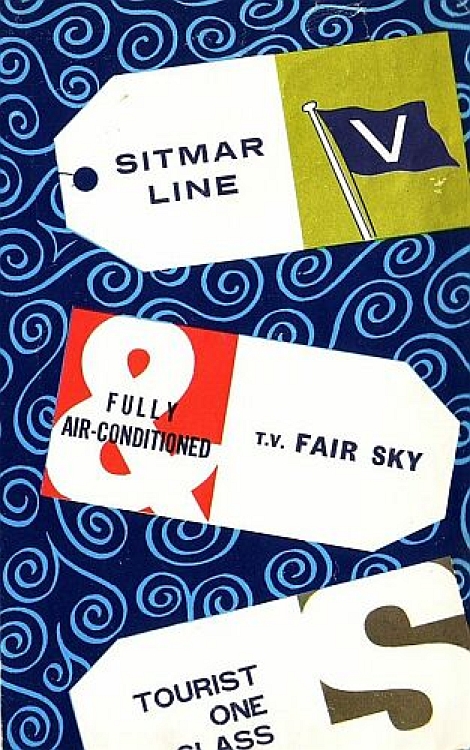
Please
Note: images below are from a Sitmar brochure, unless
mentioned otherwise
Elevators or
Lifts: SS Fairsky had six lifts; two amidships
lifts which operated between E and Sun Deck, whilst the four aft lifts operated
between C to Sun decks.
B Deck: There
were two secondary entrance halls amidships and aft on the starboard side,
whilst aft was the baggage room that would be open at various times. On the
portside aft was the ships Medical Centre and a Hospital. Balance of deck had
cabins.
A Deck: Amidships was the heart of the ship, being the “Main
Foyer” and Entrance Hall. Located forward on port and starboard sides
were offices related to the main Pursers Office, being located in the middle of
the Foyer. Whilst on the two sides aft of the Foyer was the ships Shop on the
Portside and the Ladies Beauty and Hairdressing Salon and the Barber Shop on
the starboard side.
Promenade Deck: This Deck offered three main Dining Rooms, with two forward being
Dining Rooms C and B, from forward to aft, with A
being located far aft, behind a massive Galley!
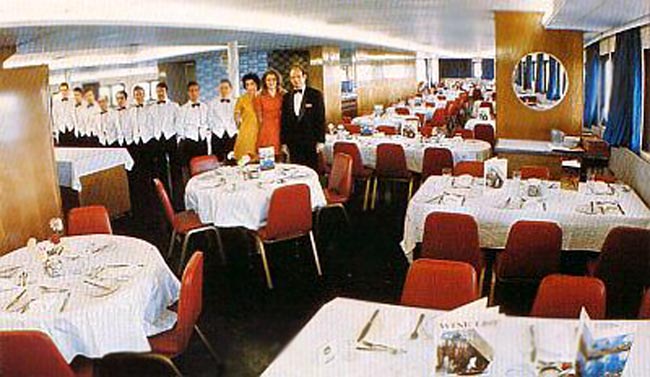
Although far
forward, just ahead of Dining Room C were two small VIP dining Rooms, which
were divided by a stairwell. Outside there was a long sheltered teak promenade
with an excellent deck space far aft!
Boat Deck: This
is the deck for all the ships main Lounges, for forward was the “Grand
Social Hall,” and the word “Grand” said it all, for it was
really huge for a ship of her size! Far forward there were two doors to small
passages, which led to doors onto a wonderful deck forward of her
superstructure, which would be available at special times! Between these doors was a special stage and bandstand and a large dance floor
that was the length of the front section of the Lounge, and that was
considerable! Far aft of the room, but centred was the Bar that serviced the
venue. The vast majority of the venue was furnished with round tables each with
four comfortable armchairs, whilst others were located with curved, in L or S
shaped long settees. In the aft section along the two sidewalls there were
comfortable back-to-back bench seating giving a warm feel of a cosy bar!
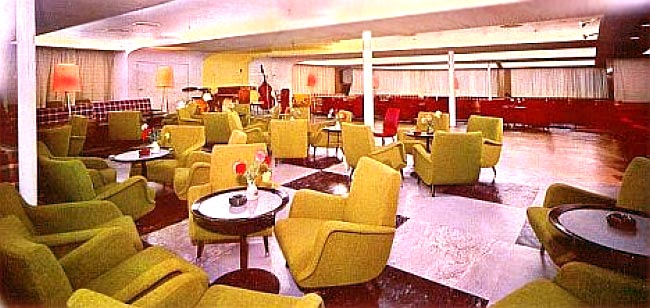
The
Grand Social Hall
Walking out
you entered the Lobby and on the starboard side was the “Children’s
Playroom” whilst on the portside was the delightful “Writing Room
and Library.” It was a beautifully timbered room, with the forward and
aft walls containing bookcases with sliding timber doors. Along the windows
here were 4 x 2, being eight writing tables with
seating for eight, perfect for those who whish to write a letter or a post
card, or even some may wish to read a book there? In addition there was seating
for 17 persons per chairs and the long bench style sofa.
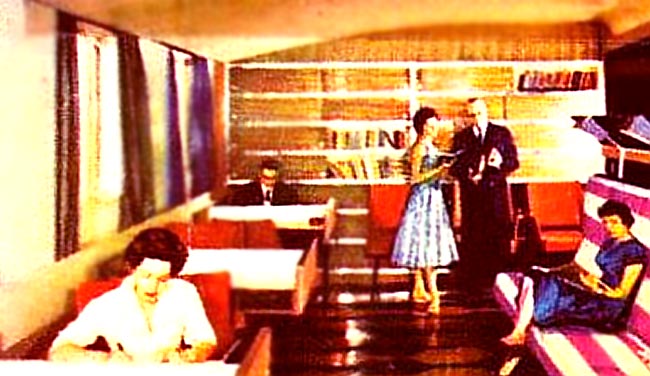
The
Writing Room and Library looking forward, the door is on the right, there is
another aft
that
enters the Beer Hall and there is a walkway behind the white and pink striped
bench sofa
You would need to
walk through Writing Room and Library to reach the next Venue, alternatively
use the aft lifts or stairwell, but you will have reached one of the most
popular venues on board and that is the “Bavarian Beer Hall.” Which
was a venue that had a timbered look with a long U shape bar located on the
starboard side and I am sure, far too many headaches resulted from a good time
in this venue!
Then the final venue aft was the delightful
“Lido Bar” which was a spacious venue that featured an aft wall of
eleven floor to ceiling glass windows and doors overlooking the ships swimming
pool and her aft decks. The venue was obviously an attractive one and thus
popular at sunset time, when Happy Hour would be a busy time!

The
Lido Lounge & Bar
Boat
Deck also offered a spacious teak deck for walking, or relaxation, under the ships
lifeboats, whilst aft was her salt water Swimming Pool and a spacious sun deck,
which offered ample seating around the pool and bar service, for soft drinks,
milk shakes, alcohol or coffee came from the Lido
bar!
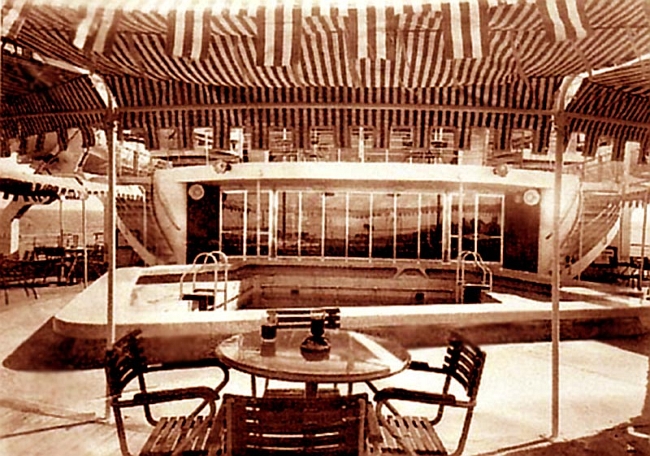
A great photo of the Pool
and looking towards the Lido Bar windows
Photographed by & © Mr. Piet Mulder
Sun
Deck: There was only one public venue and this was
located far aft and could be reached via the aft stairs or lifts. This was the
delightfully intimate “Verandah Bar.” This small venue seated just
26 persons, 3 of these being on the bar stools, the bar was located along the
starboard wall and like the Lido downstairs, this venue, except for two solid
doors, also had floor to ceiling windows the full width along her aft wall over
looking the deck outside and below. This room was especially colour full, with
the bar front featuring multi toned horizontal timber slats, and deep blues are
featured throughout, including in the furnishings, as well as grey and yellow
lampshades for contrasts! Combine this with ample greenery and you have the
perfect venue that has a great view outdoors!
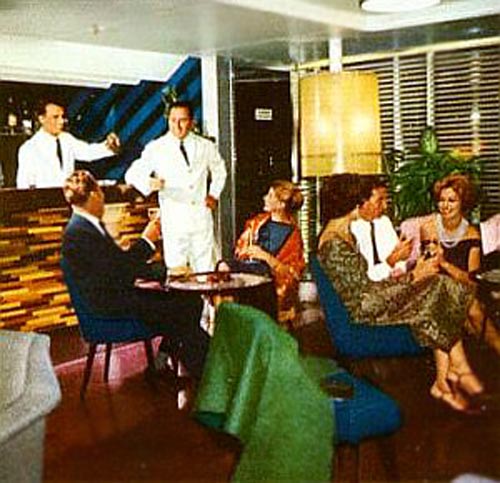
Navigation Deck: Along the aft section there was a huge Games Deck, ideal for a
host of sports and activities to be played.
A Deck Plan can be found via the Index at the bottom
of the page!
SS Fairsky (2):
From May 6 and 13,
1958 the Castel Forte was in Drydock giving time to remove all the old signage
on board, as well as removing the name Castle Forte from her hull and add the ships
official new Sitmar name the Fairsky on her bow and stern as well throughout
the ship, etc! TSS Fairsky was registered in Monrovia
on behalf of the “Fairline Shipping Corp,” being a Sitmar Company!
Once she came out of dry dock she was close to ready to commence her new
career, except for her sea trials, which proved to be successful. She was fully
manned and stocked, thus made ready for her maiden voyage in June!
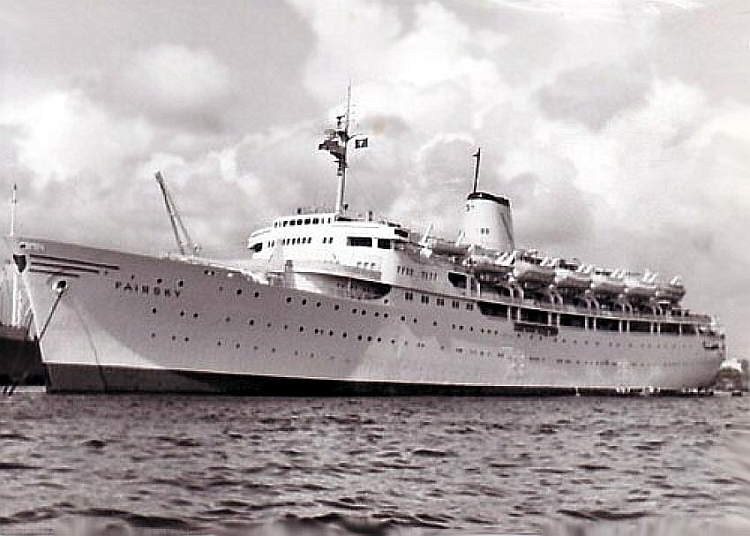
The
beautiful Fairsky is seen on her way to Australia
at anchor in Port Said
Photograph
by & © Piet Mulder
By now Sitmar had obtained the
lucrative migrant contract to take British migrants to Australia,
the famed “Ten Pound POMs” and it is for this reason she departed
from Southampton on Thursday June 26, 1958 at 2.20 pm almost full with 1,430
passengers bound for Brisbane Australia.
She sailed via Le Havre and the Suez Canal, Colombo
to Fremantle (Perth,
Western Australia), where she arrived on
Monday July 21. She then headed for Melbourne (Victoria),
arriving on Sunday July 27, departing for Sydney
(New South Wales)
arriving on Tuesday July 29, where the Fairsky remained overnight. She then
sailed north to her last official outbound destination being the City of Brisbane
(Queensland)
where she arrived on Friday August 1.
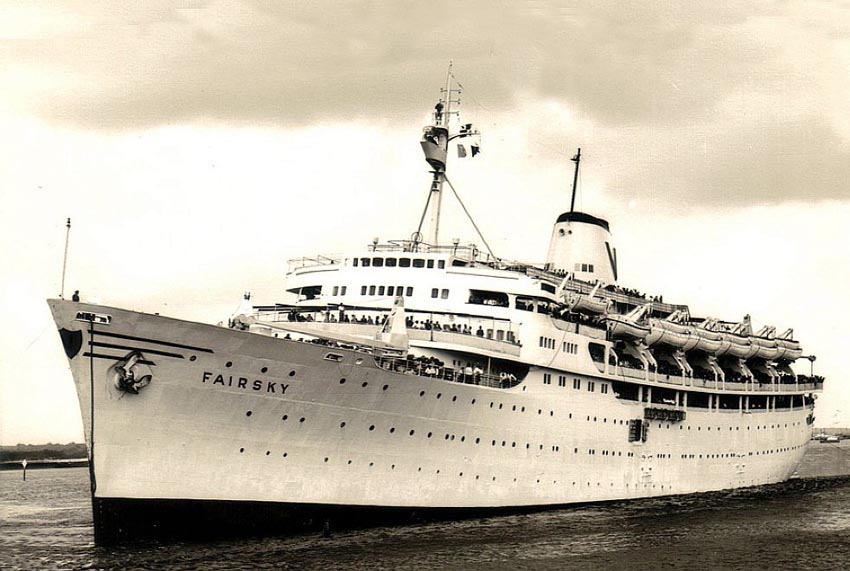
TSS
Fairsky in the Brisbane
River heading for the Hamilton
Wharves
The SS Fairsky then returned to Southampton
via the same ports of call.
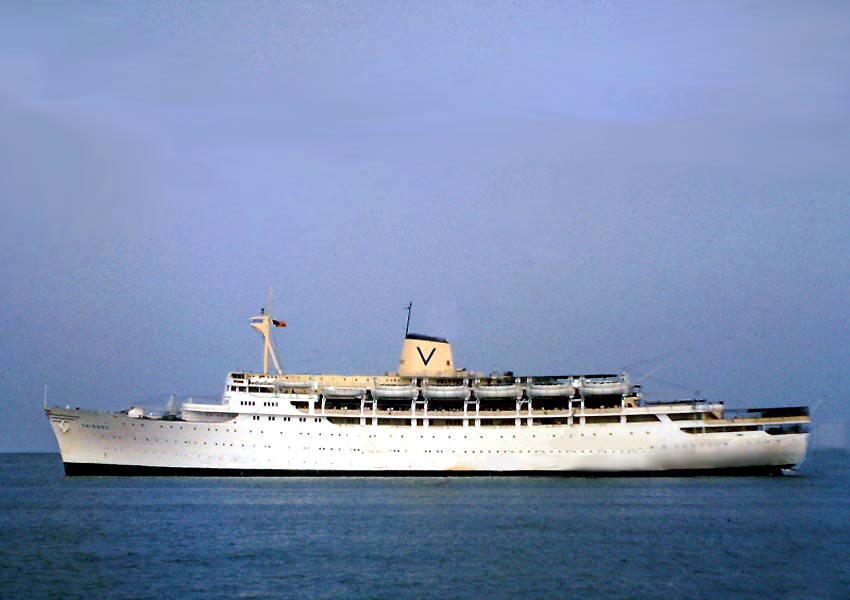
The
Fairsky was certainly one of the best conversions of a C3 Class Freighter
into a fine looking Passenger Liner
The
TSS Fairsky continued on a regular Australian service and in December 1961 she
made her very first call to Auckland New Zealand.
This was her very first of her Firsts, but there was another first to come, for
the very next year in 1962 she would undertake her very first cruise!
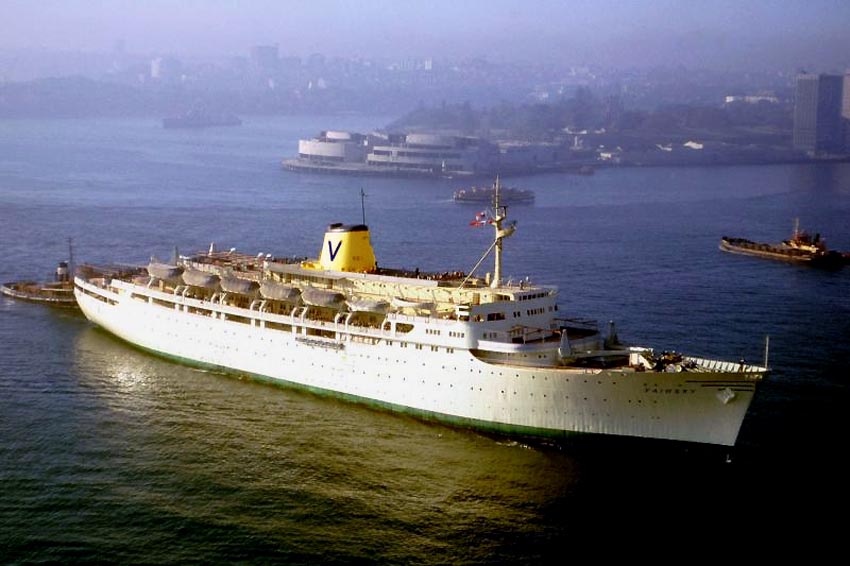
The
Fairsky seen arriving whilst the Sydney Opera House is still in construction
around 1962
Photographer
unknown - Please photo notes at bottom of page
On June 5, 1967 Egypt
imposed a blockade and closed the Suez Canal
to all shipping, and it remained closed until the very same date on June 5,
1975.
Then on June 5, 1967 the Suez Canal was closed
due to an Arab attack against Israel, which commenced the Six Day War and this
cost world shipping dearly, for suddenly cargo ships and liners alike would
have to sail all the way around the “Cape of Good Hope” in order to
reach, India and Asia in General or Australia. However, the Fairsky continued
to operate the Australian migrant service until 1970, and she became a regular
and a popular sight in Australian and also New
Zealand ports.
During the closure of the Canal it was decided
to change her schedule as follows: Rotterdam,
Southampton, Lisbon, Casablanca,
Tenerife, Cape Town, Durban,
Fremantle, Adelaide, Melbourne,
Sydney, Brisbane,
Auckland, Wellington,
Rarotonga, Suva, Pago
Pago, Papeete, Acapulco,
Balboa, Curaçao, and Azores back to Rotterdam.
The Suez Canal remained closed until the
very same date, eight years later on June 5, 1975.
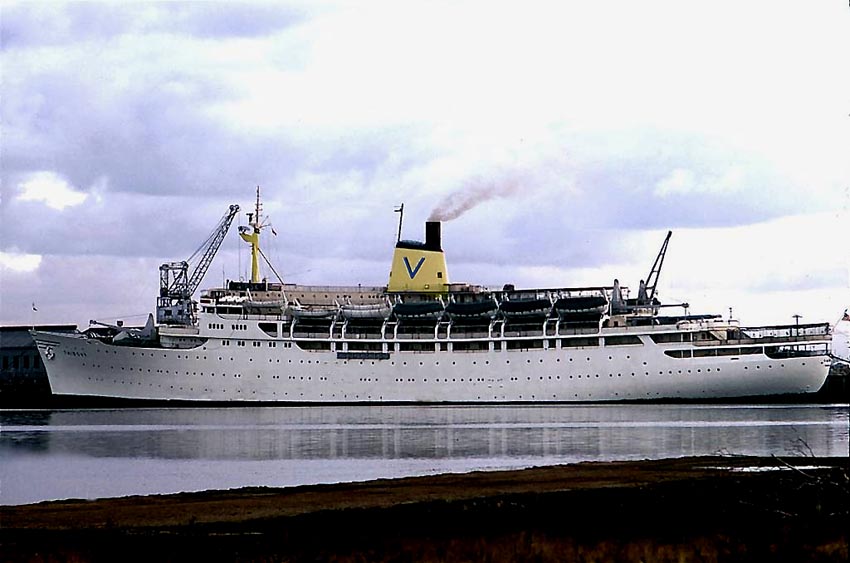
The
SS Fairsky is berthed at the Hamilton Wharves Brisbane around 1966
Photograph by & © John Wilson
During a voyage to Australia
in November 1969 the Fairsky suddenly suffered engine problems, whilst she was
sailing between Southampton and Cape
Town. Upon arrival, she had to remain there for several
days in order to undergo repairs, which was fine for the passengers, having
additional shore leave, but she then slowly limped, still not quite right to
Fremantle, arriving twelve days late. Thus further works were undertaken and
passengers were transported to their destinations.
However, Sitmar lost their Migrant
contract to the new Giant in passenger shipping the Greek Chandris Line, who
operated the ex Matson liners now named the RHMS Ellinis, Britanis and the ex
SS America,
now named the SS Australis.
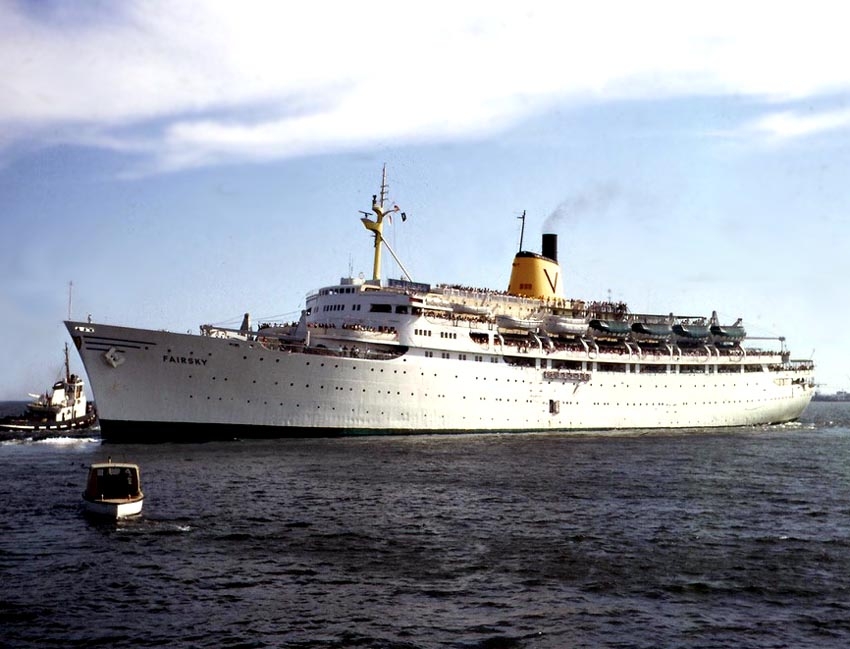
The
Fairsky is seen departing Melbourne
on January 21, 1971
Photographer
unknown - Please photo notes at bottom of page
However Sitmar continued regular
passenger serviced from Southampton to Australia
and New Zealand and did so
until February 1972, for she was then laid up in Southampton.
The main reason for the SS Fairsky being laid
up was that Sitmar had to magnificent newly rebuilt liners ready to enter
service, the TSS Fairsea and the TSS Fairwind, ex Cunard ships, the Carinthia
and Sylvania,
and Sitmar intended to use them on the Australian service. Thus the future for
the Fairsky was rather bleak at that time. The new twins were placed on the
lucrative American luxury cruise market and were met with huge success cruising
the Caribbean and Mexico
and Alaska.
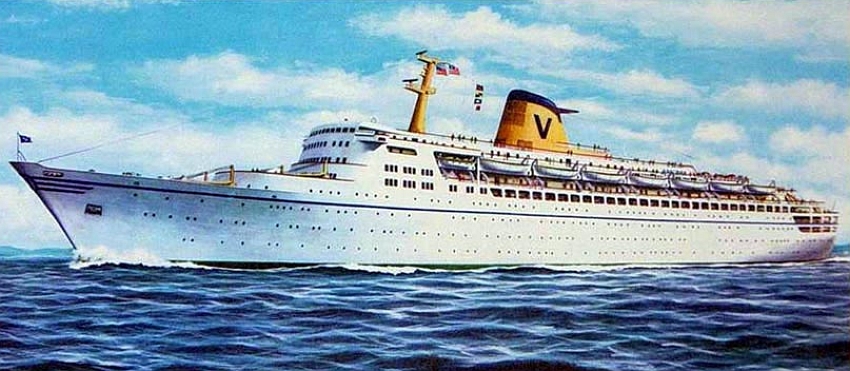
Sitmar
Lines artist impression of the new 22,000-ton TSS Fairsea and Fairwind
TSS Fairsky the Cruise Ship:
Thankfully, well over a year and
a half the TSS Fairsky had received a refit and she finally resumed her duties
and she departed Southampton on November 8, 1973 bound for Australia.
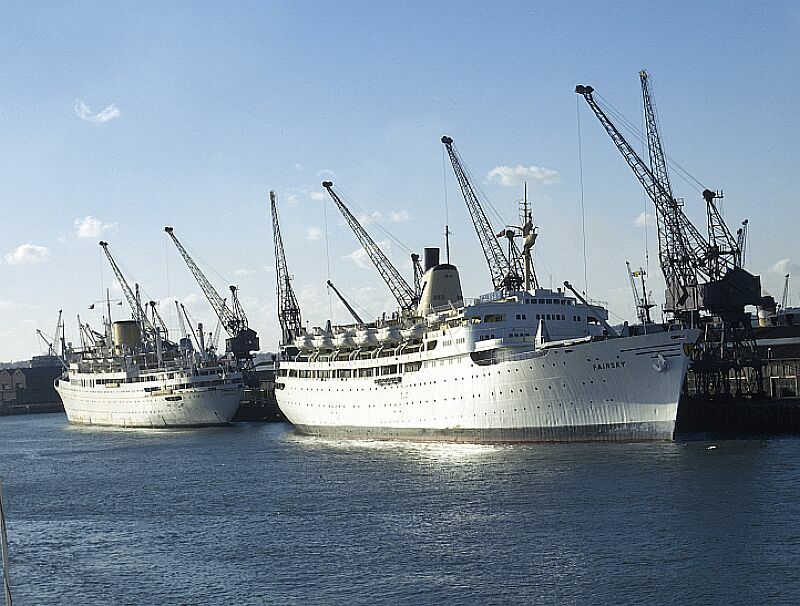
The TSS Fairsky and aft of her the MV Aureol is seen at Southampton on November 6,
1973.
Photograph with
grateful thanks; taken by John Dunworth and provided by
his friend Pete Drabble, UK.
But then on June 2, 1974 TSS Fairsky departed
Southampton what would be her very last time ever and she headed for Sydney
arriving in July and made Sydney
her homeport, for she had become a full time cruise ship! It was a wise move to
use her as a cruise ship for she was already well known and she had an excellent
reputation from her past cruises she had operated, and as she continued she
enjoyed huge success!
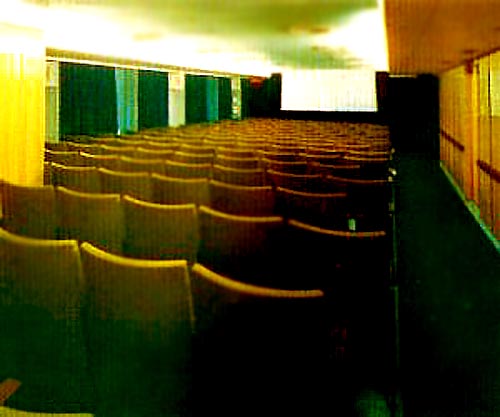
The
starboard side of the forward Dining Room was converted to become the ships
Cinema
being a must on the full time Cruise Ship and it showed a host of latest
release movies!
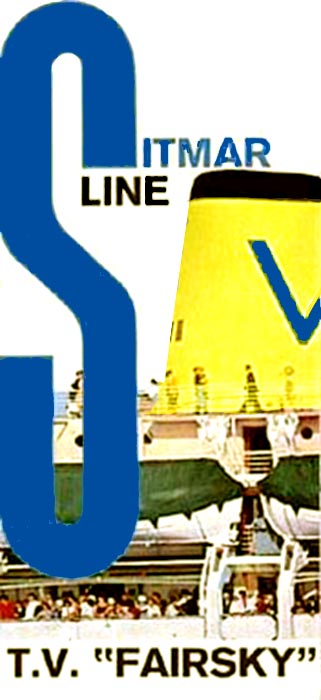
This
is a Fairsky brochure released in the 1970’s.
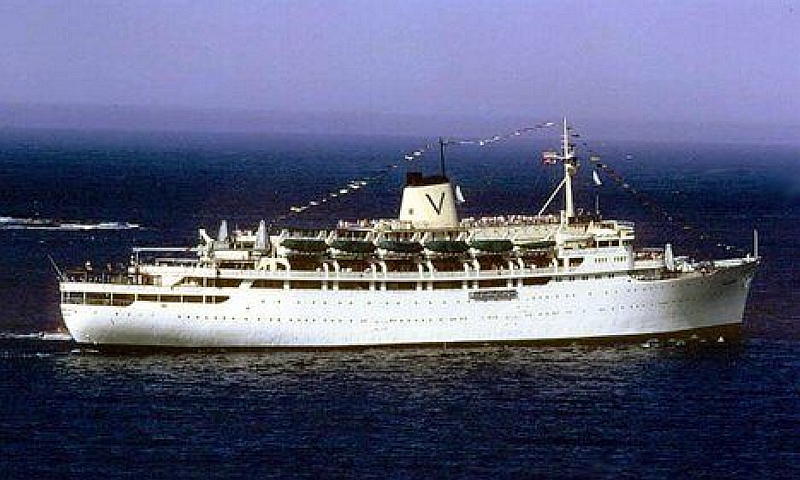
Here we
see a flag bedecked cruise ship Fairsky on a cruise
The author also enjoyed an
excellent cruise on the Fairsky, for we certainly had the most wonderful time
as we had one of the better cabins with private facilities up on Sun Deck, but
then again I have sailed on a number of Sitmar liners and cruise ships, and all
have been most enjoyable!
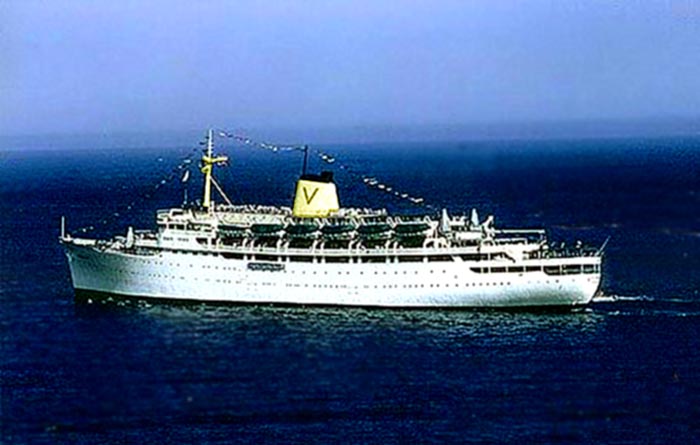
The
Fairsky was remained a good as well as a beautiful cruise ship!
Tragedy in Djakarta:
Having become a fulltime cruise
ship based in Sydney, the Fairsky departed on
a cruise to Singapore and Indonesia
and she left the last Australian port
of Darwin on June 12, 1977 and she for Singapore
for her port call and her happy passengers could have their excursions ashore.
Thereafter the ship sailed for Djakarta and
another fine day’s outing was had by all.
However, upon departing Djakarta
on June 23, the Fairsky struck the sunken the submerged wreck of an Indonesian
Combi-ship the “Klingi”, which saw the Fairsky’s hull badly
holed. The captain decided that he would beach her on a nearby sandbank to save
her from sinking. All passengers were taken ashore with great efficiency, as
passenger Mrs. Pamela Hanson writes; see the Link
to her story on the Index below.
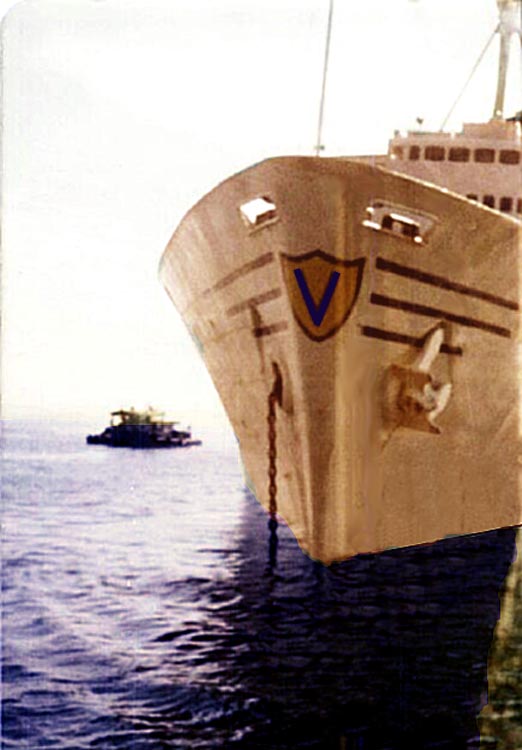
The
partially sunken bow of the Fairsky as photographed by Mrs. Hansen
Photograph
by & ©Pamela Hanson
The hole was rapidly
filled with a concrete pad on the 29th,and she was then refloated and able to proceed under her
own power to a Singapore dry-dock where a temporarily repair was made to the
damage, being a patch placed over the hole, the reason being that Sitmar had
decided not to go ahead and repair the ship, and therefore they placed her on
the market.
The Fairsky was
purchased by Fuiji Marden & Co and on December 11, 1977 she departed Singapore
bound for Hong Kong where she would be
broken up. Amazingly, the Fairsky operated this voyage under her own steam
power and sadly, it would be the very last time she would ever do so!
Whilst the Fairsky was laid up awaiting
demolition; she was suddenly purchased by a Filipino firm the “Peninsula
Tourist Shipping Corp” in March 1978, and she was renamed the
“Philippine Tourist.” The ship was taken under tow to the Bataan
Shipyard and Engineering yards in Manila, where she would be converted into a
floating hotel and casino based in Manila.
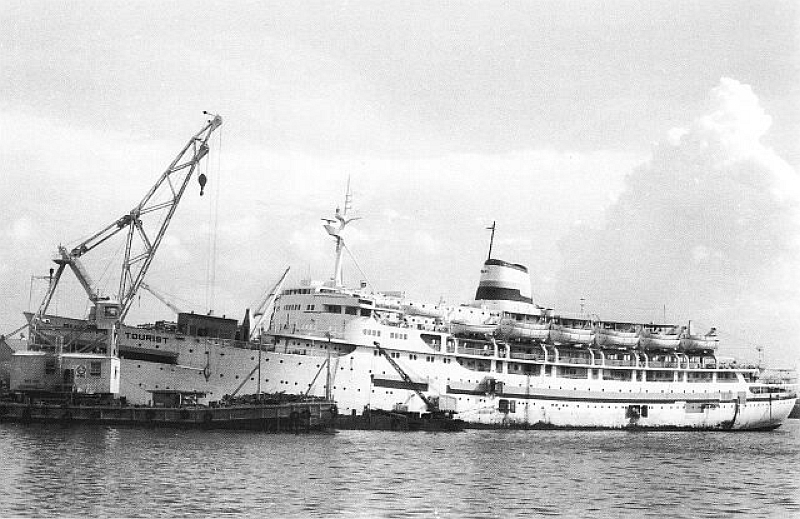
Above
& below: The Philippine Tourist is seen close to
completion - including a fine bowshot of her
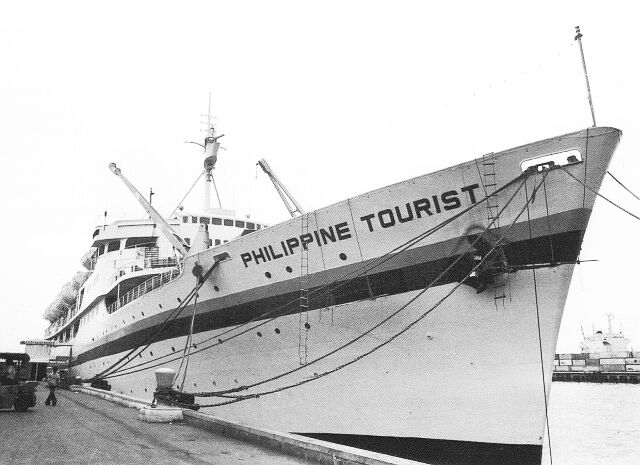
However this venture would be
short relatively short lived, for the project was doomed, it seemed almost if
the honourable War Hero, much loved Passenger Liner and Cruise Ship the Fairsky
refused to be humiliated into be reduced to becoming a hotel/casino ship, for
on November 4, 1979 with her being close to completed, she caught fire and the
ship was completely gutted.
The wreck was sold back to Fuiji Marden & Co, her previous owner, who renamed her “Fair Sky” for the
tow back to Hong Kong where she arrived on
May 24, 1979, and breaking up commenced the very next day by the very same
company who was going to break her up two years earlier!
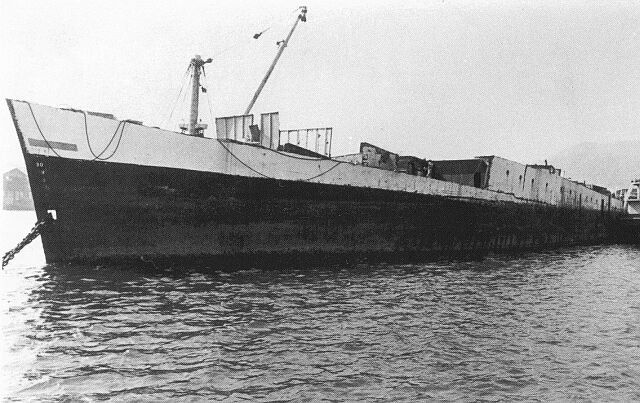
A
tragic sight, the Fair Sky almost gone as seen at the Hong
Kong breakers
Remembering
the beloved TSS Fairsky - 1957 ~ 1977
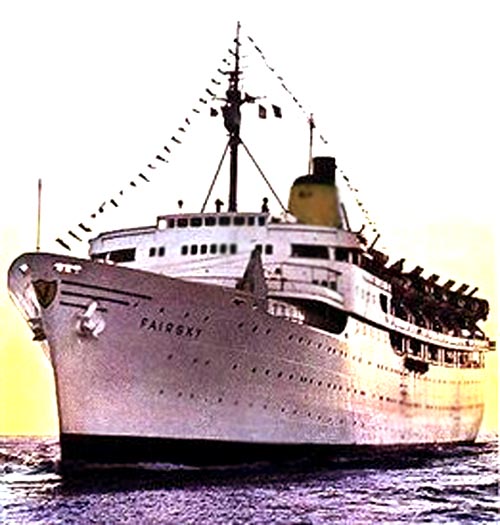
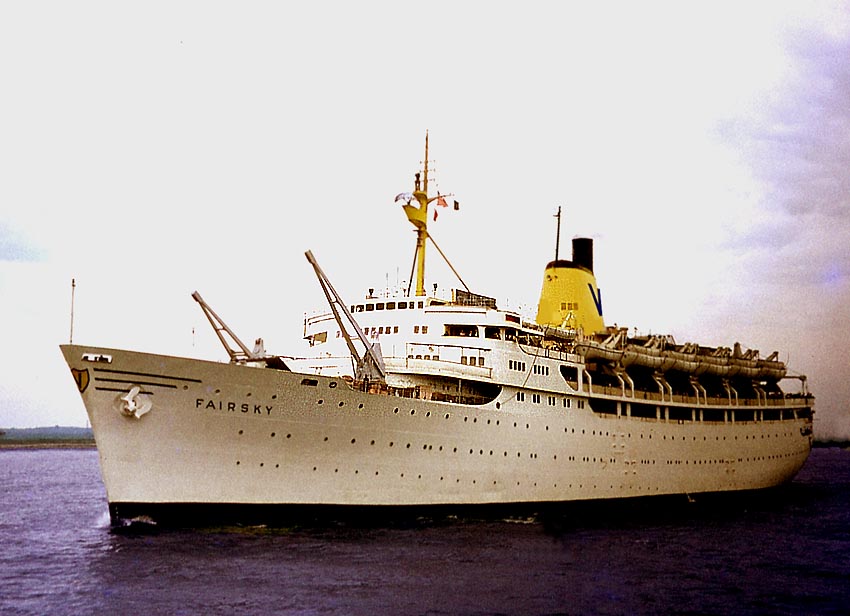
The
Fairsky always looked wonderful, as she was a beautiful ship!
Whilst cruising out
of Australia,
Sitmar had become very popular with holidaymakers and cruises became more and
more popular. Fairsky and her sisters had changed the trend in cruising for it
offered a new trend and a style that was different to the traditional British
ships. The truth is that Italian ships were simply great fun and offered
excellent food and good entertainment, which surpassed all the others! With the
Fairsky gone, came Sitmar new flagship, the 21,600-ton TSS Fairstar that later
became so lovingly known as the “Funship!”
Sitmar was so popular with not just the Australian cruise public, but it was
huge with the American and British and European market, thus in June 1988
Sitmar was taken over by P&O - Princess Cruises, who took over all their ships
the brand new SS Fairsky, the ship in building the Sitmar FairMajesty, which
was rechristened the Star Princess, currently P&O Cruises Australia Pacific
Pearl. And the two new ships designed by Sitmar and ready to be built, that
became the Regal and Crown Princess, currently P&O’s Pacific Dawn and
Jewel.
Fairsky,
the ugly duckling when built, became an attractive and popular ship for all who
sailed on her, and she will be fondly remembered by past passengers and those
who admired her from ashore!
Specifications:
IMO: 5111622.
Built by: Western
Pipe & Steel Co, San Francisco.
Laid Down: April
17, 1941.
Hull
No: 160.
Launched: September, 1941.
Delivered: December
1941.
Obtained
by Sitmar: 1950.
Refit
completed: June
1958
Tonnage: 12,464 GRT.
Length: 153m.
Beam: 21.2m.
Built: 1942 - Western Pipe & Steel Co. San
Francisco.
Machinery: GE - Geared
Steam Turbines 8,500 BHP.
Boilers: 2.
Screws: Single.
Speed: 17.5 knots.
Passengers: 1,461 One Class.
Crew: 248.
Previous
names: Castel Forte, Attacker,
Barnes, Steel Artisan.
Last names: Philippine
Tourist, Fair Sky.
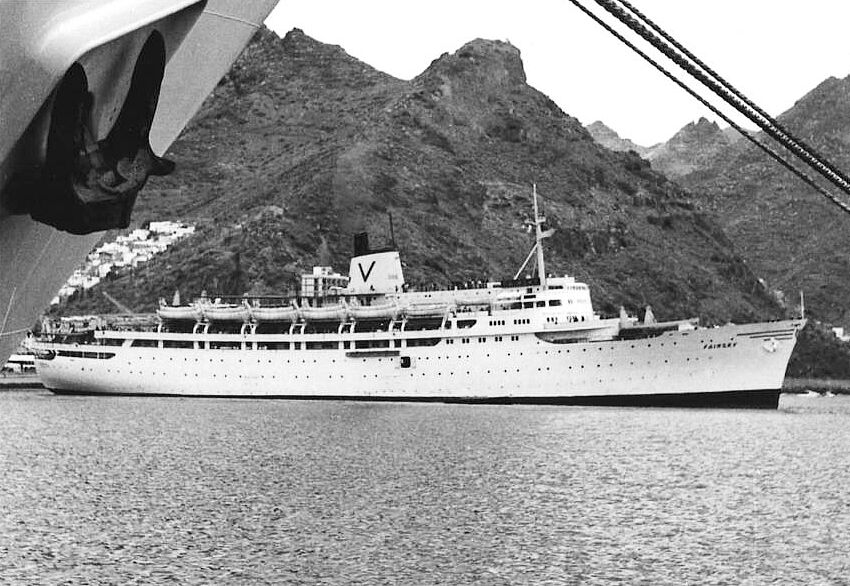
The
Fairsky seen at Tenerife in the early 1970s
Photographer
unknown - Please photo notes at bottom of page
The
Fairsky INDEX:
TSS Fairsky - Built as a C3 class freighter, the History
page - This Page.
TSS
Fairsky – Contains two Deck Plans 1958 & 1970s.
TSS
Fairsky - Piet Mulder sails on
SS Fairsky.
TSS
Fairsky - Fairsky wrecked near Djakarta
- The Pamela Hansen story.
Or Return to: The Sitmar Ships - INDEX -
For all the Other Sitmar Ships!
“Blue Water Liners sailing to
the distant shores.
I watched them come, I watched them go and I watched them die.”
****************************
Return
to the ssMaritime Main INDEX
Where
you will discover around 690 Classic Passenger & Passenger-Cargo Liners!
ssMaritime.com & ssMaritime.net
Where
the ships of the past make history & the 1914 built MV Doulos Story
Please
Note: ssmaritime and associated
sites are 100% non-commercial and the author seeks no
funding or favours of any shape or form, never have and never will!
Photographs on ssmaritime and associate pages are by the
author or from the author’s private collection. In addition there are
some images that have been provided by Shipping Companies and private
photographers or collectors. Credit is given to all contributors. However,
there are some photographs provided to me without details regarding the
photographer/owner concerned. I hereby invite if owners of these images would
be so kind to make them-selves known to me (my email address may be found on www.ssmaritime.com only), in order that due credit may be
given.
This
notice covers all pages,
although, and I have done my best to ensure that all photographs are duly
credited and that this notice is displaced on each page, that is, when a page
is updated!
ssMaritime
is owned & © Copyright by Reuben Goossens - All Rights Reserved





























